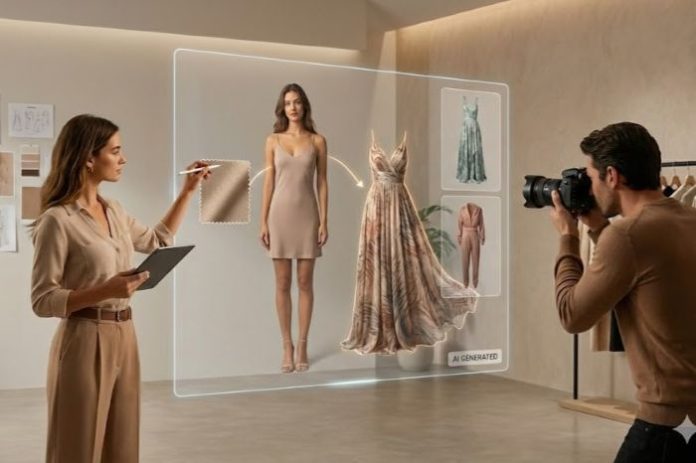Scroll any major fashion site today and you’ll see beautiful photography, slick filters, and on-brand color grading. What you won’t immediately see is the quiet revolution happening behind the scenes: product visuals are no longer fixed at the moment of the photoshoot. They’ve become dynamic, editable assets, thanks to a new class of tools often described as AI clothes changers—systems that can swap outfits on a model or mannequin in seconds, without reshoots or complex manual retouching.
This shift goes far beyond “prettier filters.” It changes how brands:
- Plan and shoot collections
- Localize visuals for markets and channels
- Test, learn, and iterate merchandising strategies
And it’s happening quietly, one PDP (product detail page) at a time.
Key Takeaways
- AI clothes changers transform static product visuals into dynamic assets, allowing for quick outfit swaps without reshoots.
- These tools lower costs, reduce lead times, and enable visual personalization for targeted marketing efforts.
- Brands can iterate creatively and run data-driven tests on visuals, enhancing merchandising strategies without high production expenses.
- The integration of AI clothes changers reshapes creative workflows, allowing for continuous iteration and less mechanical workload for designers.
- Ultimately, AI clothes changers lead to more variety and relevant visuals, marking a shift towards adaptable assets in e-commerce.
Table of contents
- From Filters to Full Outfit Changes
- 1. Shrinking the Cost of Visual Variety
- 2. Making Personalization and Localization Actually Feasible
- 3. Supercharging Creative Experimentation
- 4. Redesigning the Creative Workflow
- 5. Authenticity, Trust, and the New Visual Ethics
- 6. How to Pilot AI Clothes Changers in Your E-Commerce Business
- Beyond Filters: A Quiet but Profound Shift
From Filters to Full Outfit Changes
For years, the typical visual upgrade path has looked like this:
- Shoot the model or flat lay
- Color-correct, retouch, maybe add a filter or overlay
- Ship assets to every channel and hope they perform
Filters improve styling, but they don’t change the underlying constraints: if you didn’t shoot the red version, it doesn’t exist. If you only booked one location, you can’t magically turn an indoor studio shot into a beach scene—at least not convincingly, and not at scale.
AI clothes hangers break that limitation.
Instead of starting from scratch for each outfit or variant, brands can now:
- Upload a base image of a model or mannequin
- Prompt the system to change outfits, colors, fabrics, or styles
- Generate multiple visual variations from the same original photograph
With AI image tools like Picsman, this can all happen right in the browser: marketers and merchandisers can iterate on visuals without spinning up a full design sprint each time.
1. Shrinking the Cost of Visual Variety

Customers expect to see:
- Different colorways
- Multiple styling ideas
- Outfits on diverse body types and settings
But every new photo traditionally required more:
- Models
- Stylists
- Locations
- Retouching hours
AI clothes changers don’t eliminate the need for photoshoots, but they stretch each shoot much further:
- One base image → multiple outfits
- One model → multiple target personas (casual, formal, streetwear)
- One setting → multiple “moods” (urban, studio, seasonal)
For small and mid-sized brands, the impact is outsized:
- Lower marginal cost per visual – once the workflow is set up, new variants are cheap.
- Shorter lead times – no need to re-book talent or studios to test a new colorway online.
- Less waste – you can explore visual ideas before committing to big production budgets.
In other words: more shots on goal, for a fraction of the price.
2. Making Personalization and Localization Actually Feasible
We’ve talked about personalization in e-commerce for years—but often at the level of recommendations, not visuals. AI clothes changers make visual personalization and localization operationally realistic, not just a slide in a strategy deck.
Imagine:
- A streetwear brand serving edgier outfits on product cards for Gen Z visitors, and more classic styling for older segments—using the same underlying SKU.
- Seasonal tweaks where winter shoppers see layered looks, while summer visitors see lighter, more breathable combinations.
- Localized campaigns where the same base outfit is adapted to local norms and aesthetics across regions.
Instead of commissioning an army of photographers and stylists in every market, brands can use a single, high-quality base shoot and then adapt it via AI.
The result is not only higher relevance, but also more cohesive experimentation: the product stays constant while the outfits, contexts, and styling change.
3. Supercharging Creative Experimentation

Effective merchandisers have always had a strong intuition:
- “This dress will sell better styled with boots than with heels.”
“This jacket looks more premium in a darker palette.”
The problem? Testing those instincts has historically been expensive.
With AI clothes changers:
- You can generate multiple visual hypotheses from one photoshoot
- Deploy them in A/B tests across product pages, emails, and ads
- Let the data reveal which styling truly resonates
For example, a brand might test:
- Outfit A: minimal, monochrome styling
- Outfit B: bolder color blocking
- Outfit C: paired with accessories (bag, hat)
Within a few weeks, metrics like click-through rate, add-to-cart rate, and conversion can tell you what works. The key is that creative variation is no longer gated by production constraints, but by imagination and analytics.
4. Redesigning the Creative Workflow
Perhaps the most underrated impact of AI clothes changers is how they reshape team workflows.
In a traditional process:
- Merchandisers define the assortment
- Creative briefs go to the design / photo team
- Weeks later, assets come back for minor edits
- Visuals “lock” once campaigns launch
With AI integrated into tools like Picsman, the loop becomes much tighter:
- Base assets creation
- You still invest in a high-quality shoot.
- You still invest in a high-quality shoot.
- AI-powered exploration
- Marketers and merchandisers generate and review outfit variations directly in the browser.
- Marketers and merchandisers generate and review outfit variations directly in the browser.
- Design curation, not execution
- Designers step in to polish and approve the best variants, rather than manually creating every single one.
- Designers step in to polish and approve the best variants, rather than manually creating every single one.
- Continuous iteration
- Underperforming visuals can be swapped mid-campaign—no need to wait for the “next seasonal shoot.”
The net effect: designers move up the value chain, focusing on creative direction and brand coherence, while the repetitive, mechanical work of endless outfit variations is handled by AI.
5. Authenticity, Trust, and the New Visual Ethics
Any technology that changes how products are depicted must address a core concern: are we still being honest with customers?
AI clothes changers introduce a new responsibility for brands to:
- Avoid misrepresenting fabrics, fits, or capabilities
- Clearly disclose when visuals are significantly AI-altered
- Ensure that what customers receive matches the promise of the image
A helpful mental model is to distinguish between:
- Helpful enhancement
- Cleaning up backgrounds, adjusting lighting, generating realistic but truthful outfits.
- Cleaning up backgrounds, adjusting lighting, generating realistic but truthful outfits.
- Contextualization
- Showing how a dress works in both casual and formal contexts, without changing the underlying product.
- Showing how a dress works in both casual and formal contexts, without changing the underlying product.
- Deception
- Using AI to radically alter fit, drape, or fabric quality in ways that the physical product cannot match.
Brands that treat AI visuals as an extension of good merchandising—not as a shortcut to mislead—will be better positioned in the long run. Trust is still the ultimate conversion booster.
6. How to Pilot AI Clothes Changers in Your E-Commerce Business
You don’t need to overhaul your entire visual pipeline overnight. A practical path often looks like this:
Step 1 – Choose a constrained test case
Pick:
- 1–2 hero categories (e.g., dresses, outerwear)
- A subset of SKUs that already perform well or have clear upside
Step 2 – Create a “base shoot”
Invest in a small but high-quality photoshoot:
- Consistent lighting and angles
- Versatile poses that work across multiple outfits
- A clear idea of the stylistic directions you want to test
Step 3 – Use AI tools to generate outfit variations
With a browser-based AI editor such as Picsman, your team can:
- Swap colors and patterns
- Test different layers (jackets, scarves, accessories)
- Produce seasonal or market-specific styling variants
Step 4 – Run controlled experiments
Roll out variations in:
- A/B tests on product detail pages
- Segmented email campaigns
- Paid social ads with clear measurement
Track which combinations drive:
- Higher engagement (scroll depth, time on page)
- More adds to cart and conversions
- Better response across different audiences
Step 5 – Codify learnings into guidelines
Once you see patterns—for example, “layered looks convert better in colder regions” or “bolder colors work better on social than on PDPs”—build them into your playbooks and templates.
AI then becomes not just a tool, but a feedback loop that improves your visual strategy over time.
Beyond Filters: A Quiet but Profound Shift
AI clothes changers won’t replace photography, styling, or human creativity. What they will replace is the idea that once an image is shot, it’s fixed forever.
For e-commerce leaders, this shift means:
- More variety without exploding budgets
- Real personalization and localization at the visual level
- Faster, data-driven creative decisions
- New, more strategic roles for creative teams
We’re moving from a world where visuals are static deliverables to one where they are living, adaptable assets—edited, recombined, and optimized continuously.
That’s the real story “beyond filters.” And it’s already unfolding in the background of modern commerce, one AI-enhanced outfit at a time.











